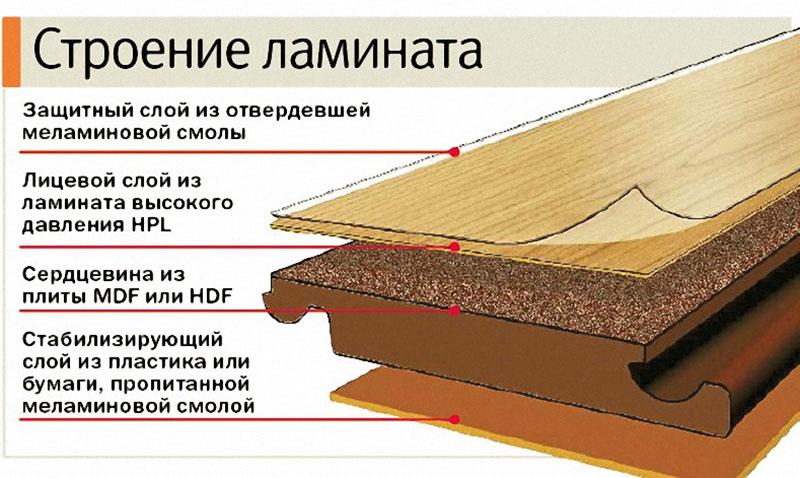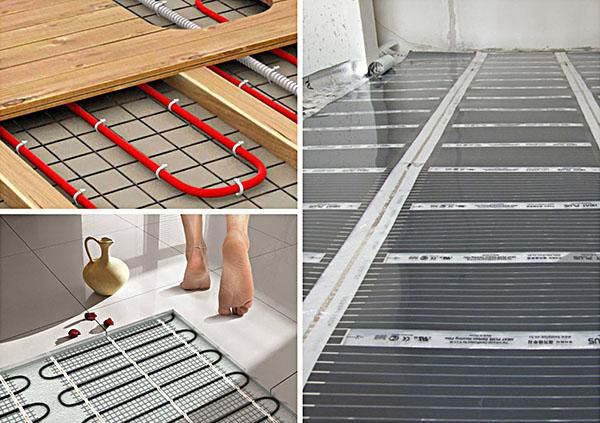Warm floor under the laminate for those who value comfort
 Don't want to lay carpets but love to walk barefoot? Warm floor under the laminate will provide your home with comfort at any time of the year. The information below will help you understand the features of the systems.
Don't want to lay carpets but love to walk barefoot? Warm floor under the laminate will provide your home with comfort at any time of the year. The information below will help you understand the features of the systems.
Warm floor under the laminate - what is important to consider

Laminate is a multi-layer coating. When the temperature rises above the permissible level (from 40 ° C and above), the resin and glue that make up it begin to release toxic substances. The amount of formaldehyde released into the air depends on the intensity of heating of the material. This has a detrimental effect on the human condition.
To protect against overheating, a thermostat is installed that controls the temperature and turns off the system if necessary.
For residential premises with heated floors, choose a flooring with an E0 (or at least E1) emission index, with a concentration of volatile substances below the permissible level.
Subject to the rules, heating is easily installed under the laminate flooring.
Types of floor heating

There are 2 types of floor heating systems:
- Electric (cable and infrared).
- Water.
The choice of the type of underfloor heating depends on several factors, including the base material. On the wooden floor, the underfloor heating system under the laminate is laid without a concrete screed, since wooden floors are not designed for heavy weight.
Consider the permissible rise in the floor height above the base plane. The concrete screed increases the floor surface height up to 60 mm. If raising the upper surface of the floor is not appropriate, use subtle types of floor heating.
Electric underfloor heating under laminate
 Electrical systems are of 2 types: cable and film. The first is carried out directly from the heating cable or from heat mat.
Electrical systems are of 2 types: cable and film. The first is carried out directly from the heating cable or from heat mat.
The advantages of electrical varieties:
- low price;
- ease of installation;
- quiet work;
- convenient temperature control;
- durability (service life up to 50 years).
Disadvantages:
- high energy consumption;
- electromagnetic radiation;
- heavy load on the electrical network.
Before installation, draw a plan for the layout of the warm floor under the laminate.
Cable underfloor heating
 Consists of a heating cable laid in a snake or a spiral under floor covering... Suitable for any floor surface.
Consists of a heating cable laid in a snake or a spiral under floor covering... Suitable for any floor surface.
Installation is carried out on a reinforcing mesh or a special tape with clamps.
Cable underfloor heating must be laid in a layer of concrete screed and connected to a thermostat.
Advantages of cable systems:
- low cost;
- uniform heating.
Disadvantages:
- expensive operation (high energy costs);
- the need for grounding and a thick concrete screed (from 3 cm);
- the complexity of installation;
- slow warming up of the room.
Think over the layout of the room in advance. To avoid overheating and breakdown of the system, the warm floor must be laid under a space free of furniture.
Thermomats
 This is a type of cable system. Only here the heating elements are immediately placed in mesh mats. The mesh can be cut into sections (without breaking the cable integrity). The cable section is smaller than in the previous version. The whole structure is rolled up.
This is a type of cable system. Only here the heating elements are immediately placed in mesh mats. The mesh can be cut into sections (without breaking the cable integrity). The cable section is smaller than in the previous version. The whole structure is rolled up.
Thermal mats are used when it is not possible to fill in a thick screed.
Benefits of mats:
- convenience of design (wires are fixed at the required distance from each other);
- ease of installation (for quick fixation, the mesh is covered with an adhesive layer from below);
- savings in installation (concrete screed is 5-10 mm thinner, installation is performed without mounting tape);
- minimum increase in floor height.
The disadvantage is the high price compared to the previous option.
Infrared (film) warm floor under the laminate
 It is a thin material that emits electromagnetic pulses with a frequency of 5 to 25 microns. Under the influence of radiation, the surrounding objects are heated.
It is a thin material that emits electromagnetic pulses with a frequency of 5 to 25 microns. Under the influence of radiation, the surrounding objects are heated.
The thermal film should be cut according to the marked marks (at a distance of about 25 cm).
The advantages of using a film underfloor heating under a laminate:
- environmental safety (under the influence of infrared radiation, the coating does not emit toxic substances);
- the safety of the floor covering (the laminate does not delaminate and does not diverge, as when heated with heat mat or cable);
- compactness (due to the absence of a cement screed);
- efficiency (low power consumption).
Disadvantages:
- high price;
- short service life (up to 15 years).
When using thermal film as the main heating, the film must cover at least 70% of the area. In severe winter conditions, infrared systems are used as additional heating.
Most often, it is a film warm floor that is mounted under the laminate.
Thermal film is not used in rooms with high humidity and is not placed near heat sources.
Water heat-insulated floor under the laminate
 This is a complex of flexible pipelines through which a heat carrier (hot water) circulates, which transfers thermal energy to the floor covering. The liquid is heated in the boiler and moves in a closed loop thanks to the circulation pump.
This is a complex of flexible pipelines through which a heat carrier (hot water) circulates, which transfers thermal energy to the floor covering. The liquid is heated in the boiler and moves in a closed loop thanks to the circulation pump.
Laying of a water-heated floor is carried out under a specially designed laminate. Electric heating flooring is not suitable for water systems.
To prevent the laminate from deforming from the effects of water heating, choose a coating with a grade of at least 32 class and a thermal resistance within 0.15 m² K / W.
Styling features
 Water heat-insulated floors are usually used in low-rise buildings. This system can operate independently of networks and resource supply companies. The main thing is to constantly maintain the circulation of the coolant in winter. Otherwise, pipes may freeze and damage them.
Water heat-insulated floors are usually used in low-rise buildings. This system can operate independently of networks and resource supply companies. The main thing is to constantly maintain the circulation of the coolant in winter. Otherwise, pipes may freeze and damage them.
Before installing a water-heated floor in a high-rise building, it is necessary to clarify whether there is a second heating system to which the warm floor is connected. If it is not there, then for the installation of water heating you will need permission from the housing management company.
The pressure in the heating system of multi-storey buildings is not sufficient for the free movement of liquid through the floor heating pipelines. Therefore, a blockage of the coolant is possible, which causes a complication of heating the room, and sometimes - blockage and freezing of the pipeline.
Hot water floor heating is suitable for a residential home with a heated floor area of more than 70 m22.
Water underfloor heating is laid using a concrete screed or using a flooring method. In the first case, a water-heated floor under the laminate is laid on a concrete floor that can withstand high loads created by an additional layer of concrete.
 Pipes for the coolant are poured concrete... As a result, a thick layer of screed is formed, which accumulates heat and transfers it evenly to the floor covering.
Pipes for the coolant are poured concrete... As a result, a thick layer of screed is formed, which accumulates heat and transfers it evenly to the floor covering.
To prevent part of the thermal energy from heating the base, it is necessary to perform high-quality insulation.
The laying method of laying a warm floor under a laminate is used on wooden floors (floors). It is the laying of pipelines without screed. In this case, the system must work more intensively, since the heat transfer in the dry process is reduced.
Advantages of water underfloor heating:
- ease of installation;
- the ability to work autonomously, not depending on resource providers;
- no effect on the humidity in the room;
- environmental Safety;
- economy (heating occurs only in a heating boiler).
Disadvantages:
- high price;
- the complexity of the repair;
- low thermal conductivity of the coating with the floor installation method;
- the need for regular service;
- high load on the system caused by intensive operation.
What kind to choose
First of all, start from the type of base, determine the possibility of using a concrete screed. Only infrared or water heat-insulated floors ("dry" method) are laid on wooden floors without screed.
Then, explore the pros and cons of different types of underfloor heating systems. Determine which is more important to you - price, durability, environmental friendliness or ease of installation. Armed with the information and advice provided, choose the right equipment.